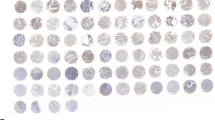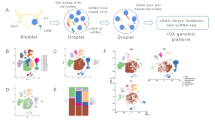Abstract
Human urinary bladder cancer (UBC) is the fourth most common cancer and the eighth most common cause of cancer death in the USA. High mobility group box 3 (HMGB3), a member of a family of proteins containing one or more high mobility group DNA binding motifs, was reported to be overexpressed in a variety of human cancers. However, the expression and role of HMGB3 in human UBC remains unclear. Here, we found that UBC patients had upregulated HMGB at both mRNA and protein levels. Immunochemistry (IHC) evaluation of HMGB3 expression in 113 UBC clinical specimens showed that high expression of HMGB3 had positive correlation with UBC tumor size (P = 0.019), tumor WHO grade (P = 0.031), stage (P = 0.028), and lymph node metastasis (P = 0.017). Moreover, patients with higher HMGB3 expression showed a poorer overall survival rate than those with relatively low HMGB3 (P = 0.0079, log-rank test). Multivariate analysis revealed that HMGB3 expression is an independent prognostic marker. The UBC cancer cell proliferation and migration ability were measured by 3-(4, 5-dimethylthiazol-2-yl)-2, 5-diphenyltetrazolium bromide (MTT) and wound healing assays, respectively. RNA interference of HMGB3 in UBC cell lines inhibited cancer cell growth and migration, along with the downregulation of PCNA and MMP2 protein levels. In sum, our data suggests HMGB3 may serve as an important oncoprotein and indicate that overexpression of HMGB3 in UBC could be used as a potential prognostic marker.




Similar content being viewed by others
References
Jemal A, Bray F, Center MM, Ferlay J, Ward E, Forman D. Global cancer statistics. CA Cancer J Clin. 2011;61(2):69–90.
Galustian C. Tools to investigate biomarker expression in bladder cancer progression. BJU Int. 2013;112(3):404–6.
Kaufman DS, Shipley WU, Feldman AS. Bladder cancer. Lancet. 2009;374(9685):239–49.
Prasad SM, Decastro GJ, Steinberg GD, Medscape. Urothelial carcinoma of the bladder: definition, treatment and future efforts. Nat Rev Urol. 2011;8(11):631–42.
Siegel R, Ma J, Zou Z, Jemal A. Cancer statistics, 2014. CA Cancer J Clin. 2014;64(1):9–29.
Wu XR. Urothelial tumorigenesis: a tale of divergent pathways. Nat Rev Cancer. 2005;5(9):713–25.
Vishnu P, Mathew J, Tan WW. Current therapeutic strategies for invasive and metastatic bladder cancer. Onco Targets Ther. 2011;4:97–113.
Stros M. HMGB proteins: interactions with DNA and chromatin. Biochim Biophys Acta. 2010;1799(1–2):101–13.
Somervaille TC, Matheny CJ, Spencer GJ, Iwasaki M, Rinn JL, Witten DM, et al. Hierarchical maintenance of MLL myeloid leukemia stem cells employs a transcriptional program shared with embryonic rather than adult stem cells. Cell Stem Cell. 2009;4(2):129–40.
Ben-Porath I, Thomson MW, Carey VJ, Ge R, Bell GW, Regev A, et al. An embryonic stem cell-like gene expression signature in poorly differentiated aggressive human tumors. Nat Genet. 2008;40(5):499–507.
Elgamal OA, Park JK, Gusev Y, Azevedo-Pouly AC, Jiang J, Roopra A, et al. Tumor suppressive function of mir-205 in breast cancer is linked to HMGB3 regulation. PLoS One. 2013;8(10):e76402.
Tang HR, Luo XQ, Xu G, Wang Y, Feng ZJ, Xu H, et al. High mobility group-box 3 overexpression is associated with poor prognosis of resected gastric adenocarcinoma. World J Gastroenterol. 2012;18(48):7319–26.
Gong Y, Cao Y, Song L, Zhou J, Wang C, Wu B. HMGB3 characterization in gastric cancer. Genet Mol Res. 2013;12(4):6032–9.
Song N, Liu B, Wu JL, Zhang RF, Duan L, He WS, et al. Prognostic value of HMGB3 expression in patients with non-small cell lung cancer. Tumour Biol. 2013;34(5):2599–603.
Zhou J, Bi H, Zhan P, Chang C, Xu C, Huang X, et al. Overexpression of HP1gamma is associated with poor prognosis in non-small cell lung cancer cell through promoting cell survival. Tumour Biol. 2014;35(10):9777–85.
Dyrskjot L, Kruhoffer M, Thykjaer T, Marcussen N, Jensen JL, Moller K, et al. Gene expression in the urinary bladder: a common carcinoma in situ gene expression signature exists disregarding histopathological classification. Cancer Res. 2004;64(11):4040–8.
Lu DY, Leung YM, Cheung CW, Chen YR, Wong KL. Glial cell line-derived neurotrophic factor induces cell migration and matrix metalloproteinase-13 expression in glioma cells. Biochem Pharmacol. 2010;80(8):1201–9.
Tong ZT, Wei JH, Zhang JX, Liang CZ, Liao B, Lu J, et al. AIB1 predicts bladder cancer outcome and promotes bladder cancer cell proliferation through AKT and E2F1. Br J Cancer. 2013;108(7):1470–9.
Zhu F, Zhang Z, Wu G, Li Z, Zhang R, Ren J, et al. Rho kinase inhibitor fasudil suppresses migration and invasion though down-regulating the expression of VEGF in lung cancer cell line A549. Med Oncol. 2011;28(2):565–71.
Petit A, Ragu C, Della-Valle V, Mozziconacci MJ, Lafage-Pochitaloff M, Soler G, et al. NUP98-HMGB3: a novel oncogenic fusion. Leukemia. 2010;24(3):654–8.
Nemeth MJ, Kirby MR, Bodine DM. Hmgb3 regulates the balance between hematopoietic stem cell self-renewal and differentiation. Proc Natl Acad Sci U S A. 2006;103(37):13783–8.
Malmstrom PU, Wester K, Vasko J, Busch C. Expression of proliferative cell nuclear antigen (PCNA) in urinary bladder carcinoma. Evaluation of antigen retrieval methods. APMIS. 1992;100(11):988–92.
Gao X, Mi Y, Ma Y, Jin W. LEF1 regulates glioblastoma cell proliferation, migration, invasion, and cancer stem-like cell self-renewal. Tumour Biol. 2014;35(11):11505–11.
Acknowledgments
The study was supported by a grant from the “Twelve-Five Plan” of the Major Program of Jiangsu Medical Science and Technique Development Foundation and Young Professionals Foundation of Huai’an First People’s Hospital.
Conflicts of interest
None
Author information
Authors and Affiliations
Corresponding author
Additional information
Minghui Li and Yong Cai contributed equally to this work.
Rights and permissions
About this article
Cite this article
Li, M., Cai, Y., Zhao, H. et al. Overexpression of HMGB3 protein promotes cell proliferation, migration and is associated with poor prognosis in urinary bladder cancer patients. Tumor Biol. 36, 4785–4792 (2015). https://doi.org/10.1007/s13277-015-3130-y
Received:
Accepted:
Published:
Issue Date:
DOI: https://doi.org/10.1007/s13277-015-3130-y




